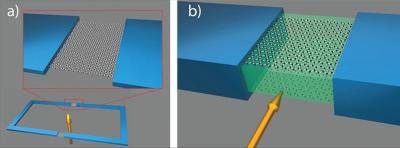Researchers at the University of Basel in Switzerland, Budapest University of Technology and Economics in Hungary and National Institute for Material Science in Japan have developed a new, super-small device that is capable of detecting minute magnetic fields.
 A conventional SQUID (left) and the new SQUID (right). (University of Basel, Department of Physics)
A conventional SQUID (left) and the new SQUID (right). (University of Basel, Department of Physics)
The device, a new kind of superconducting quantum interference device (SQUID), is just 10 nanometres high, or around a thousandth of the thickness of a human hair. It's made from two layers of graphene making it one of the smallest SQUIDs ever built separated by a very thin layer of boron nitride.
"Our novel SQUID consists of a complex, six-layer stack of individual two-dimensional materials," says physicist David Indolese from the University of Basel in Switzerland. "If two superconducting contacts are connected to this sandwich, it behaves like a SQUID meaning it can be used to detect extremely weak magnetic fields."
Conventional SQUIDs work as a ring a superconducting loop that has two 'weak link' points. By analyzing the travel of electrons around this loop, and the threshold at which the SQUID stops being a superconductor, magnetic fields can be measured.
While these devices are already able to spot faint magnetic fields, the size of the weak links is a limitation. By switching to a stacked design, rather than a loop, the team behind the new SQUID can detect magnetic fields that are even fainter.
One possible (if rather technical) application of SQUIDs is in closely examining topological insulators: materials that act as insulators, but which also can have electrons travelling over their surface.
"With the new SQUID, we can determine whether these lossless supercurrents are due to a material's topological properties, and thereby tell them apart from non-topological materials," says physicist Christian Schönenberger from the University of Basel.
Anywhere that magnetic fields need to be measured, SQUIDs are important. Now, those measurements can be even more precise.

